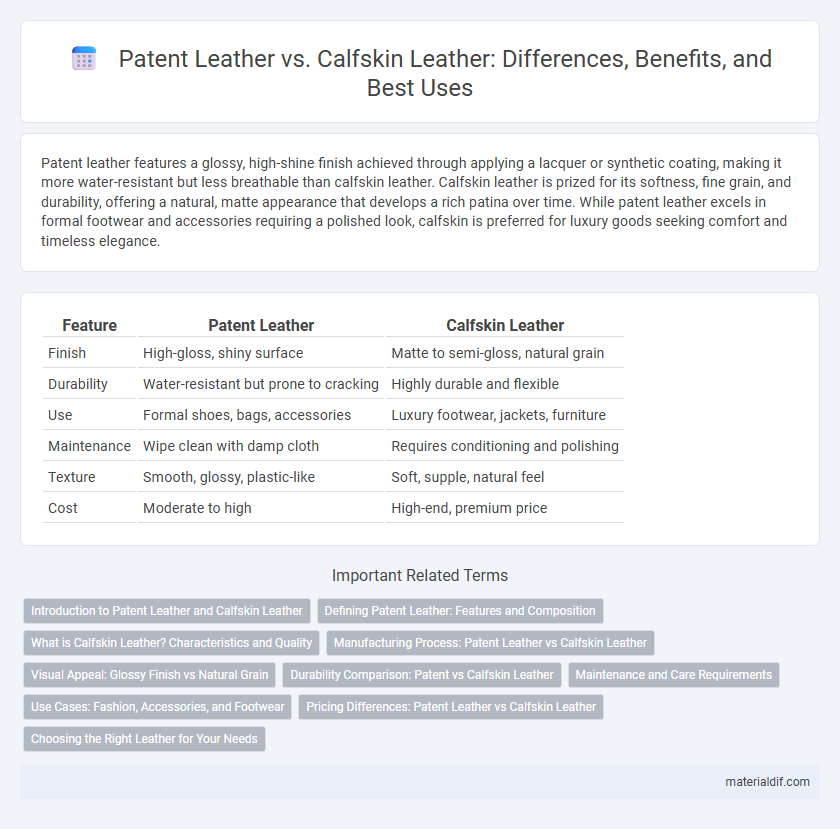Patent leather features a glossy, high-shine finish achieved through applying a lacquer or synthetic coating, making it more water-resistant but less breathable than calfskin leather. Calfskin leather is prized for its softness, fine grain, and durability, offering a natural, matte appearance that develops a rich patina over time. While patent leather excels in formal footwear and accessories requiring a polished look, calfskin is preferred for luxury goods seeking comfort and timeless elegance.
Table of Comparison
| Feature | Patent Leather | Calfskin Leather |
|---|---|---|
| Finish | High-gloss, shiny surface | Matte to semi-gloss, natural grain |
| Durability | Water-resistant but prone to cracking | Highly durable and flexible |
| Use | Formal shoes, bags, accessories | Luxury footwear, jackets, furniture |
| Maintenance | Wipe clean with damp cloth | Requires conditioning and polishing |
| Texture | Smooth, glossy, plastic-like | Soft, supple, natural feel |
| Cost | Moderate to high | High-end, premium price |
Introduction to Patent Leather and Calfskin Leather
Patent leather features a high-gloss, mirror-like finish achieved through a coating process that enhances its waterproof and stain-resistant properties. Calfskin leather, sourced from young calves, is prized for its fine grain, softness, and durability, making it ideal for luxury leather goods and footwear. The distinct textures and finishes of patent leather and calfskin offer unique aesthetic and functional qualities for fashion and accessory applications.
Defining Patent Leather: Features and Composition
Patent leather is characterized by its high-gloss finish achieved through a coating of lacquer or synthetic resin, providing an impermeable, shiny surface that resists water and stains. It typically features a smooth, polished texture over a base of fine leather, often calfskin, which enhances durability and flexibility. The composition of patent leather involves a multi-layered process that includes tanning, lacquering, and buffing to create its signature reflective sheen and uniform appearance.
What is Calfskin Leather? Characteristics and Quality
Calfskin leather, derived from young calves, is prized for its fine grain, smooth texture, and exceptional softness, making it a premium choice in luxury goods and fashion. It boasts high durability and breathability, along with a natural sheen that improves with age and proper care. Unlike patent leather, calfskin lacks a glossy coating, offering a more supple feel and a matte to slight satin finish that highlights its natural grain.
Manufacturing Process: Patent Leather vs Calfskin Leather
Patent leather undergoes a unique manufacturing process where a leather base, typically calfskin, is coated with multiple layers of lacquer or plastic to achieve its characteristic glossy finish and water resistance. In contrast, calfskin leather is tanned using traditional methods such as vegetable or chrome tanning, preserving its natural texture and flexibility without additional coating. The manufacturing divergence results in patent leather being more durable against moisture but less breathable, while calfskin maintains softness and breathability suitable for high-quality leather goods.
Visual Appeal: Glossy Finish vs Natural Grain
Patent leather features a highly glossy finish achieved through a coating that creates a reflective, mirror-like surface, enhancing its sleek and polished appearance. Calfskin leather displays a natural grain texture, showcasing subtle variations and a matte or slightly lustrous finish that highlights its organic beauty. The visual appeal of patent leather is striking and modern, while calfskin offers a timeless and sophisticated look rooted in authenticity.
Durability Comparison: Patent vs Calfskin Leather
Patent leather offers a high-gloss finish with moderate durability, making it resistant to water and stains but prone to scuffs and cracks over time. Calfskin leather boasts superior durability due to its dense fiber structure, allowing it to withstand wear and develop a rich patina with age. Choosing between patent and calfskin leather depends on balancing the need for aesthetic shine against long-term resilience and aging qualities.
Maintenance and Care Requirements
Patent leather demands regular wiping with a damp cloth and occasional polishing to maintain its glossy, reflective surface, while avoiding abrasive cleaners that can damage the finish. Calfskin leather requires more intensive conditioning with leather-specific creams to preserve its softness and prevent cracking, alongside protection from excessive moisture and direct sunlight. Both types benefit from storage in a cool, dry environment, but calfskin's porous nature makes it more susceptible to stains and thus necessitates prompt cleaning.
Use Cases: Fashion, Accessories, and Footwear
Patent leather's high-gloss finish makes it ideal for formal footwear, handbags, and fashion accessories that require a polished, elegant look, often featured in evening wear and special occasions. Calfskin leather, prized for its softness, durability, and natural grain, is commonly used in luxury fashion items, high-end wallets, belts, and durable yet stylish footwear suitable for everyday wear. Both materials cater to distinct market segments, with patent leather emphasizing aesthetics and calfskin prioritizing comfort and longevity in accessory design.
Pricing Differences: Patent Leather vs Calfskin Leather
Patent leather typically commands higher prices than calfskin leather due to its glossy, polished finish that requires additional manufacturing processes, increasing production costs. Calfskin leather, known for its soft texture and durability, is priced moderately, reflecting its natural grain and less intensive treatment. Market demand also influences pricing, with patent leather favored in fashion items demanding a sleek appearance, thereby often justifying its premium.
Choosing the Right Leather for Your Needs
Patent leather offers a glossy, polished finish that is highly durable and resistant to water, making it ideal for formal shoes and accessories. Calfskin leather provides a soft, supple texture with excellent breathability and flexibility, suited for everyday wear and premium leather goods. Selecting between patent leather and calfskin depends on the desired balance between aesthetic shine and comfort for your specific use.
Patent Leather vs Calfskin Leather Infographic

 materialdif.com
materialdif.com